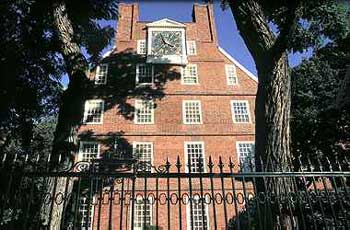





Survey of
Historic Sites and Buildings
 |
MASSACHUSETTS HALL Massachusetts |
|
| ||
Ownership and Administration (1961). Harvard University.
Significance. Erected between 1718 and 1720, Massachusetts Hall is the oldest surviving building of the first colonial institution for higher learning. As such, it possesses great significance not only in the history of American education but also in the story of the developing English Colonies of the 18th century.
Harvard College was founded in 1636, although it did not receive its name and begin its active existence until 2 years later. Even though the founding and early years of the college belong to the 17th century, Massachusetts Hall, built in the early years of the 18th century, illustrates notably the striving for intellectual development and the first groping toward education liberalism in the century that saw the Colonies become the United States of America. Although a leading function of Harvard was to supply clergymen for the Colonies, its graduates in fact entered all walks of colonial life. The liberal arts course was patterned on that of Oxford and Cambridge, both of which recognized degrees from Harvard. The college was the site of the first laboratory for experimental physics prior to the Revolution, and it developed a strong curriculum in mathematics and physical sciences. Most of the students in the 18th century came from New England, but the college rolls reveal also a scattering of young men from more southerly mainland Colonies, Bermuda, and the West Indies.
 |
| Massachusetts Hall. |
Massachusetts Hall was designed by Harvard Presidents John Leverett and his successor Benjamin Wadsworth. It was originally a dormitory containing 32 chambers and 64 small private studies for the 64 students it was designed to house. During the siege of Boston, 640 American soldiers took quarters in the hall. Much of the interior woodwork and hardware, including brass doorknobs, disappeared at this time.
Present Appearance (1961). The building has three full stories with a fourth under the broad gambrel roof. "The walls are plainly treated," Hugh Morrison has commented, "marked only by brick belt courses between stories; the brick masonry is laid in English bond below the water table and in Flemish bond above, except at the ends where there is a mixture of English and common bonds. The simple mass and heavy woodwork of the windows give a very satisfactory effect of solidity, and it is this effect—an early Georgian simplicity and weight—which has been sought in the recent buildings of Harvard." [26]
 |
 |
http://www.cr.nps.gov/history/online_books/colonials-patriots/sitec15.htm
Last Updated: 09-Jan-2005